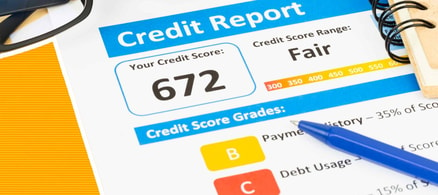1. Start by building credit

Have at least one active credit card.
When you’re an adult, having no credit is just as bad as having bad credit, because lenders have no idea what kind of spender or borrower you are, and they’ll refuse to loan you money. So, the first step to having a good credit score is to establish some credit.
One option might be to apply for a credit card for those with limited or no credit history. These credit cards have a low limit, which allows you to make small purchases and pay down your credit card each month.
There are also options to build credit without using a credit card. Credit Strong, from Austin Capital Bank, provides an option to build credit with a savings account. When you open a Credit Strong account, they give you a small loan and place the funds into a locked savings account in your name. You make small monthly payments of principal and interest on your loan. When the loan is repaid in full, the lock is removed from your savings account. Credit Strong reports your progress to all 3 major credit bureaus.
Kiss Your Credit Card Debt Goodbye
Having a single loan to pay off makes it easier to manage your payments, and you can often get a better interest rate than what you might be paying on credit cards and car loans.
Fiona is an online marketplace offering personalized loan options based on your unique financial situation.
When you consolidate your debt with a personal loan, you can roll your payments into one monthly installment. Find a lower interest rate and pay down your debt faster today.
Get Started2. Learn your credit score

To build your credit, you'll first need to know what your score is.
To get your credit score, you can pay credit reporting agencies like Equifax, TransUnion or Experian for their score — but there are also ways to get a credit score for free.
3. Get a free credit report

Request a credit report, it's free!
Under the Fair Credit Reporting Act, consumers are entitled to free copies of each of their credit reports every 12 months. To request your reports, just go to AnnualCreditReport.com.
The reports can be transmitted electronically in an instant, or you can have hard copies delivered to you within 15 days of your request.
Stop overpaying for home insurance
Home insurance is an essential expense – one that can often be pricey. You can lower your monthly recurring expenses by finding a more economical alternative for home insurance.
SmartFinancial can help you do just that. SmartFinancial’s online marketplace of vetted home insurance providers allows you to quickly shop around for rates from the country’s top insurance companies, and ensure you’re paying the lowest price possible for your home insurance.
Explore better rates4. Dispute any mistakes on your credit report

Check your credit report carefully for any mistakes.
Your credit report might have errors or inconsistencies in it that are lowering your score. Check your credit report carefully to make sure you’re not being penalized for unnecessary mistakes.
If you find an error, ask for a dispute form from the agency within 30 days of getting your report. It’ll take about a month for the mistakes to fall off your record, but after that, you’ll be thrilled to see your credit score go up.
And while it's nice to get a free credit score, credit monitoring services like Credit Sesame are often far more valuable in the long run, as they can help you minimize the risk of fraud and errors on your account.
5. Apply for a secured credit card

Secured credit cards are training wheels for your credit score.
A secured credit card is a great way to start building a solid foundation of credit — consider it "training wheels" for your credit score.
Here’s how it works: Your bank sets a limit on the card -- let’s say $500. You give the bank $500 up front as a deposit, should you ever default on your payments. The card then functions as a regular credit card.
After making regular payments on the card for a few months to a year, you will have enough credit to apply for a regular credit card with better benefits and a higher spending limit.
6. Become an authorized user on someone else’s account

Have a spouse or parent sign you up as an authorized user.
Ask a family member or significant other to add you as an authorized user on one of their cards. This one requires a fair bit of trust, since the primary cardholder is responsible to cover your bill if you fail to pay it.
Don’t sour a good relationship — make a serious commitment to pay your end of the bill every month.
Important: Check with the card issuer to make sure your authorized credit use is reported to the major credit bureaus. Otherwise, all your hard work to build good credit won't even get recorded.
7. Pay off your cards in full each month

Avoid paying unecessary interest fees.
It should go without saying, but pay your bills on time. Failing to do so will destroy the credit that you’re working to build.
Don’t let debt linger and accumulate — pay off your cards in full at the end of each month (yes, in full, not just the minimums!)
8. Keep your credit utilization low

Don't max out your credit cards.
Your credit utilization is the percentage of your available credit that you're using. For example, if you have one credit card with a $1,000 limit and you're carrying a $500 balance, then you're at 50% credit utilization.
Try to keep your credit usage at 30% or less, and avoid maxing out your cards unless you’re absolutely certain you can pay the balance in full and on time.
9. Avoid opening too many new accounts

Too many accounts are as bad as none.
Your favorite department store is offering a shiny new credit card and you’re feeling the temptation to sign up? Resist! Pretend there are snakes in the store and leave.
Part of your credit score depends on the "age" of your accounts, so having too many new accounts lowers the age of your credit history. Having a longer or "older" history gives you more clout with lenders and raises your credit score.
10. Keep your accounts open as long as possible

Keep your credit pristine by leaving open accounts that are in good standing.
Remember, the age of your accounts and the longer you’ve been in good standing on your credit report will reflect positively in the eyes of creditors. Closing an account that’s been in good standing could potentially wipe away years of good credit, putting you back at square one.
Avoid closing any open accounts and instead leave your card at home if you can’t resist the urge to spend.
More: Create an account and start monitoring your credit with Credit Sesame.
Sponsored
Follow These Steps if you Want to Retire Early
Secure your financial future with a tailored plan to maximize investments, navigate taxes, and retire comfortably.
Zoe Financial is an online platform that can match you with a network of vetted fiduciary advisors who are evaluated based on their credentials, education, experience, and pricing. The best part? - there is no fee to find an advisor.








